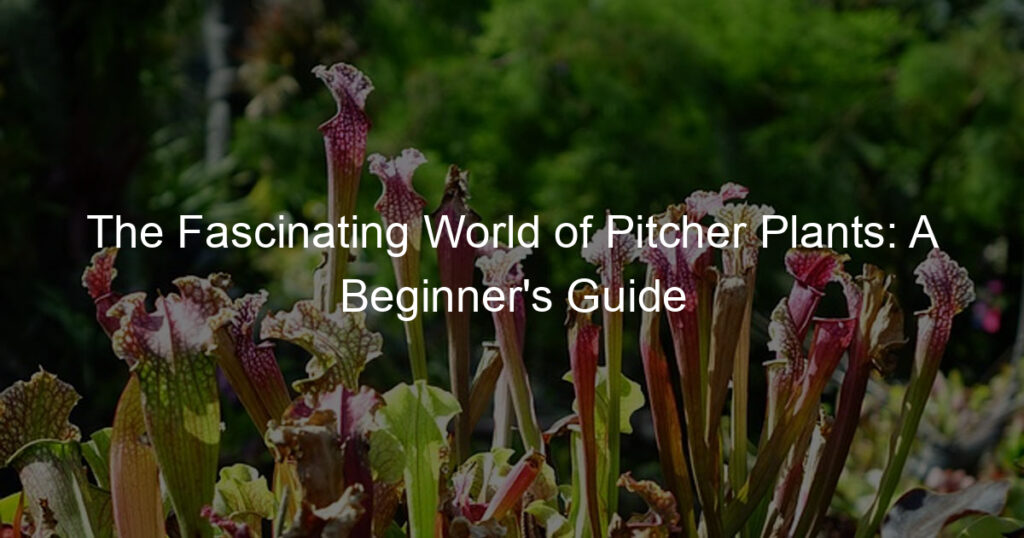If you’ve recently become interested in pitcher plants and their unique carnivorous characteristics, then you’re in luck! With all the different species of pitcher plant out there, it can be a bit daunting to get started. That’s why I’m here – to walk you through the fascinating world of pitcher plants, from an introduction to basic facts about these incredible plants to helpful tips for creating your terrarium.
What are pitcher plants?
Pitcher plants are pretty interesting. They’re carnivorous plants that live mainly in moist, sunny environments like bogs and humid forests. They get their name from their distinct look- the plant has a modified leaf or stems that looks like a deep vase with slippery walls and is filled with liquid to trap prey like flies.
When the insect lands on the pitcher, it can’t hold on to the slick walls and falls into the liquid where they are eventually digested by enzymes secreted by the pitcher plant! This unique behavior is no doubt fascinating and even led Charles Darwin to call them “the most wonderful creation of nature.”
How do pitcher plants work?
Pitcher plants are certainly something out of a horror movie! These unique carnivorous plants draw in their prey with a combination of sweet scents, colorful visual cues, and slippery sides so they can capture and digest insects.
The inside of the pitcher is lined with downward-pointing hairs that keep bugs inside while also providing an area for the plant to secrete digestive juices. This process eventually breaks down and liquefies insects so the plant’s roots can absorb nutrients.
What are the different types of pitcher plants?
Pitcher plants are a unique type of carnivorous plant that can be found throughout the world. While there may be variations in their appearance, most pitcher plants share common features such as an inner bowl lined with special hairs and secretions that attract and trap insects from the environment.
In terms of popularity, five species are especially well-known; Sarracenia purpurea, Sarracenia flava, Darlingtonia californica, Nepenthes rajah, and Nepenthes ventschii. Sarracenia purpurea is native to North America and can vary in size depending on location; some grow only three or four inches tall while others can reach 30 inches higher.
Sarracenia flava is also present in the United States and appears in bright yellow colors with veins even exhibiting a reddish hue. Darlingtonia californica stands out with an exquisite shape featuring a long hood filled with curved bristles while Nepenthes rajah has nectar glands located beneath its large upper lip which makes it stand out as a “masterpiece” among its peers.
Lastly, Nepenthes ventschii is native to Southeast Asia and produces very colorful pitchers but requires more heat making cultivation more difficult than other species of pitcher plants.
How to care for pitcher plants?
Caring for pitcher plants is surprisingly easy. To keep your plant healthy, avoid direct sunlight and provide adequate moisture by misting the leaves once a day or when the soil starts to feel dry.
Fertilize lightly twice a month using low concentrations of liquid fertilizer. Regularly check for any pests such as aphids and mealybugs, which can be removed with a cotton swab soaked in alcohol diluted with water.
If necessary, you can trim back overgrown parts of the plant and repot it in a well-draining soil mix at least every two years. With a bit of attention, you’ll watch your pitcher plant thrive!
Can pitcher plants be grown indoors?
Growing a pitcher plant indoors can provide a unique and captivating addition to any living space. These carnivorous plants thrive in conditions that many other houseplants would find uncomfortable; such as high humidity, partial sun, and wet soil.
Plus, they act as their mini-ecosystems: they consume insect pests while providing shelter and nourishment to beneficial bugs. All of this makes them an interesting and easy-to-care-for choice for any green thumb looking to add something extraordinary to their indoor garden.
Where can I buy pitcher plants?
Buying pitcher plants can be a tricky endeavor, as not many traditional plant stores carry them. One of the best options for finding pitcher plants to buy is online. There are a variety of websites that sell all sorts of species – from smaller young plants to larger more mature specimens.
Prices tend to vary depending on the size and quality of the plant, but most online retailers have reasonable prices so you can easily add a pitcher plant or two to your home collection.
Conclusion
The fascinating world of pitcher plants is a truly incredible one that has much to offer novice gardeners and seasoned experts alike. Whether you’re looking for an unusual houseplant or landscaping element, these botanical marvels are sure to fill your needs. Furthermore, these carnivorous treasures come in many shapes and forms, from the giant pitcher plants of South East Asia to the colorful lowland species that can be found on the coasts of North America.








